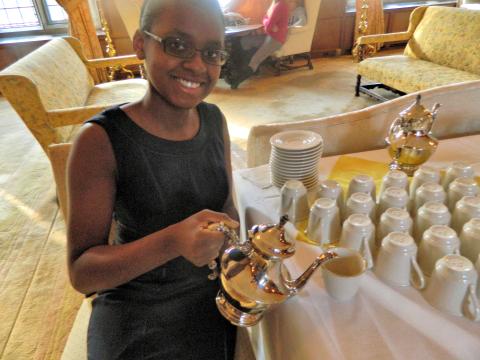By Catherine Walsh Davis ’70, MM’76 and Kathy Graneggen Moberg ‘79
If there has been one constant over MCB’s first 100 years, it is probably afternoon tea. But even this iconic element has undergone changes in practice almost from day one. It began as a daily routine when the Building opened and was meant to be a mechanism for teaching social skills to the young women of the Building. While it may have done that too, the young women of the Building chose to make the affair their own and determined it would be a respite from the cares of the academic world and would have “a cozy atmosphere that promotes closer understanding and fellowship,” as it was put in the 1924 Annual.
While special teas have always been held on the first floor, daily tea was originally an informal gathering in the second floor library. During the 1925 – 26 school year, afternoon tea in the Blue Room (called the Gold Room after a 1961 redecoration) became the standard. Teas, as described in that year’s Annual, were very much like those held today: “More fun! We sit on the floor, drink tea, and chat – so cozy – and every day, too! Men and all!”
Daily tea continued apace, even through the financial upheaval of the Depression and into the new decade of the 40s. Then, in her September/October 1942 report to the Governors, MCB Social Director, Leona Diekema, wrote unsettling news about the daily tea hour. "This very pleasant and distinctive feature of life in the Martha Cook Building, like Lucky Strike Green, has gone to war. The tea shortage made this change imperative although the sugar shortage also precludes home-made sweets for such uses.” Afternoon tea did not return to Martha Cook until the fall semester 1944 when, still due to rationing, it was only served on Fridays, and the tradition that continues today began.
A running theme throughout MCB history has been to share tea with others in the University community and to call some fetes “special teas.” Today, “special tea” usually means the food is more elaborate than at a routine tea and it may also mean a specific group of people (usually, but not always, men) has been invited as guests. In the pre-World War II years, a special tea was often a tea dance, sometimes, as at the first Lawyers Tea in 1934, with male participants, but not always. Pauline Putnam, House Board Vice President for 1937-38 reported in her annual report that a tea dance in honor of the Building’s new women was “a strictly girls affair” and that an outside pianist provided the music for dancing. Sometimes, a small orchestra was hired.
The desire to invite large portions of the University community to share tea is a trait that crosses the generations but the means of doing that has been different over the years. In the early years to immediately post-World War II, University guests were sent individual invitations to a Garden Party Tea held in May. On April 29, 1917, residents entertained faculty, serving sandwiches in festive May baskets made of colored paper. Between 1929 and 1931, this became an “Old English Festival” with upwards of 500 faculty guests and residents resplendent in elaborate costumes of medieval court ladies and Robin Hood characters. In 1945, 981 guests were invited; 600 attended.
The International Tea has humbler origins. Tea for the Cosmopolitan Club, U-M’s first international student organization, was a regular event in MCB’s early social calendars. As described in the 1926 Annual, “Almost every nation was represented – very interesting. After tea we sang patriotic songs of different countries.” The first tea to be called an International Tea was held in November 1947 when the residents decided to participate in the campus’s International Week by inviting foreign students to the regular Friday tea, a far cry from the premier all-campus event we know today. Periodically, over the years, Cookies continued to honor international students at regular Friday teas and began to add information booths and entertainment. House Board minutes reveal that by 1983 the tea had taken on that form, although the minutes did not indicate that the event was an “open” affair until 1988. That was also the first occasion that the length of time for an International Tea was extended beyond one hour.

Through the years, Martha Cook women have adapted a beloved tradition to meet their own needs while maintaining the same dedication to building and preserving a strong community. Each woman who has lived at MCB can agree with Henry James, “There are few hours in life more agreeable than the hour dedicated to the ceremony known as afternoon tea.”

